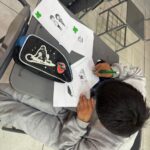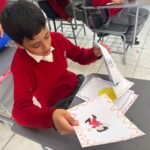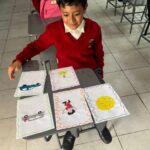Área de Inglés
LAS FLASH CARDS
OBJETIVO:
Se las utiliza como una herramienta didáctica visual que permita a los estudiantes adquirir, reforzar y recordar vocabulario y estructuras del idioma inglés, promoviendo el aprendizaje significativo a través de la asociación de imágenes y palabras, la repetición espaciada y el juego interactivo.
Principales características de las flashcards en el aprendizaje del idioma inglés:
- Visuales y llamativas
Utilizan imágenes, colores y diseños que captan la atención y facilitan la asociación entre palabras y significados. - Sencillas y específicas
Cada tarjeta presenta una sola palabra, frase o concepto, lo que ayuda a enfocar el aprendizaje y evita la sobrecarga de información. - Portátiles y prácticas
Son fáciles de transportar y usar en cualquier lugar, lo que permite su empleo en distintas actividades dentro y fuera del aula. - Reforzadoras del vocabulario y la memoria
Ayudan a memorizar y recordar palabras en inglés a través de la repetición y la asociación visual. - Versátiles y dinámicas
Se pueden usar en juegos, repasos, actividades grupales o individuales, adaptándose a diferentes niveles y estilos de aprendizaje.
Uso de las flashcards dentro del aula:
- Presentación de nuevo vocabulario
- Muestra la flashcard con la imagen o palabra.
- Pronuncia la palabra en voz alta.
- Pide a los estudiantes que repitan varias veces.
- Asocia la palabra con una acción o situación para darle contexto.
- Juegos de memoria (Memory Game)
- Coloca las tarjetas boca abajo (imagen vs palabra).
- Los estudiantes deben voltear dos tarjetas: si coinciden, se las quedan.
- Gana quien tenga más pares al final.
- ¿Qué falta? (What’s missing?)
- Muestra varias flashcards.
- Pide a los estudiantes que cierren los ojos.
- Retira una tarjeta y pregunta: “What’s missing?”
- Los estudiantes deben identificar la palabra faltante.
- Clasificación de palabras
- Entrega a los estudiantes varias flashcards.
- Pídeles que las clasifiquen por categorías: colores, animales, comidas, verbos, etc.
- Luego, pueden compartir en inglés: “This is a fruit.” / “This is a color.”
- Mímica con flashcards (Charades)
- Un estudiante saca una tarjeta sin mostrarla.
- Debe representarla con gestos.
- Los demás adivinan en inglés: “Is it a cat?” / “It’s jumping!”
- Repetición con ritmo o canciones
- Usa las flashcards como base para crear rimas, canciones o repeticiones rítmicas.
- Ejemplo: “Apple, apple, red and sweet!” (mientras muestran la tarjeta).
- Formación de oraciones
- Entrega varias flashcards de sustantivos, verbos y adjetivos.
- Los estudiantes deben formar oraciones completas con ellas.
- Ejemplo: [boy] [eats] [apple] → “The boy eats an apple.”
- Competencias por equipos
- Divide la clase en grupos.
- Muestra una flashcard rápidamente.
- El grupo que diga primero la palabra correcta gana un punto.
Conclusiones:
- Las flashcards permiten a los estudiantes asociar palabras con imágenes, lo que mejora la retención y comprensión del nuevo vocabulario de manera significativa.
- Su uso en juegos, dinámicas grupales o actividades interactivas estimula la motivación de los estudiantes y crea un ambiente de aprendizaje más atractivo y participativo.
- El uso de flashcards contribuye al fortalecimiento de las habilidades de escucha, pronunciación, lectura y construcción de oraciones en inglés, especialmente en niveles iniciales.
FLASHCARDS
Objective:
They are used as a visual didactic tool that helps students acquire, reinforce, and recall vocabulary and structures of the English language, promoting meaningful learning through the association of images and words, spaced repetition, and interactive games.
Main characteristics of flashcards in English language learning:
- Visual and eye-catching
They use images, colors, and designs that grab attention and facilitate the association between words and meanings. - Simple and specific
Each card presents a single word, phrase, or concept, which helps focus learning and avoids information overload. - Portable and practical
They are easy to carry and use anywhere, allowing them to be used in various activities inside and outside the classroom. - Vocabulary and memory enhancers
They help memorize and recall English words through repetition and visual association. - Versatile and dynamic
They can be used in games, reviews, group or individual activities, adapting to different levels and learning styles.
Using flashcards in the classroom:
- Introducing new vocabulary
- Show the flashcard with the image or word.
- Say the word out loud.
- Have students repeat it several times.
- Associate the word with an action or situation to give it context.
- Memory Game
- Place the cards face down (image vs. word).
- Students turn over two cards; if they match, they keep them.
- The student with the most pairs at the end wins.
- What’s Missing?
- Show several flashcards.
- Ask students to close their eyes.
- Remove one card and ask: “What’s missing?”
- Students must identify the missing word.
- Word Classification
- Give students several flashcards.
- Ask them to sort them into categories: colors, animals, food, verbs, etc.
- Then, they can share in English: “This is a fruit.” / “This is a color.”
- Charades with flashcards
- One student picks a card without showing it.
- They must act it out using gestures.
- The others guess in English: “Is it a cat?” / “It’s jumping!”
- Rhythm or song repetition
- Use flashcards as a basis to create rhymes, songs, or rhythmic repetitions.
- Example: “Apple, apple, red and sweet!” (while showing the card).
- Sentence formation
- Provide flashcards with nouns, verbs, and adjectives.
- Students must form complete sentences using them.
- Example: [boy] [eats] [apple] → “The boy eats an apple.”
- Team competitions
- Divide the class into groups.
- Show a flashcard quickly.
- The team that says the correct word first wins a point.
Conclusions:
- Flashcards allow students to associate words with images, improving retention and understanding of new vocabulary in a meaningful way.
- Their use in games, group dynamics, or interactive activities boosts student motivation and creates a more engaging and participatory learning environment.
- Flashcards contribute to the development of listening, pronunciation, reading, and sentence-building skills in English, especially at beginner levels.




